If a person notices that the skin on the lower extremities has begun to peel and look dry and unhealthy, then they definitely need proper care. However, before starting any action, it is recommended to go for a consultation with a doctor, who will make a preliminary diagnosis and, if necessary, prescribe additional examination.
After all, it also happens that such symptoms are not only cosmetic in nature, but also signal serious disorders in the body. Human skin is a kind of protective barrier, thanks to which the body remains healthy. This becomes possible due to the fact that the skin does not allow many unfavorable factors to enter: toxins, bacteria, etc.
Initially, you need to figure out why the skin on your legs below the knees is peeling, and only then begin therapeutic or cosmetic measures to restore its normal appearance. Of course, first of all, dry skin of the lower extremities is unsightly, but this condition is often accompanied by unpleasant sensations: itching, pain, peeling, redness, burning, etc.
Causes
In total, doctors identify 5 groups of reasons why such changes occur:
- influence of external factors;
- age-related changes in the body;
- progression of chronic diseases;
- infectious lesion;
- poor nutrition.
Let's look at each point in more detail.
It’s worth saying right away that most of the factors that lead to peeling of the skin on the legs below the knees can be eliminated without much effort and specific treatment. Many people who have a fairly sensitive epidermis have peeling feet when exposed to aggressive wind, sun, cold, water and air. People with dry skin type suffer the most under such conditions.
The solution to the problem may be to use a rich cream when you go outside in frosty weather, but if it’s summer outside, then cosmetics with increased ultraviolet protection will come in handy (men should also not neglect these recommendations). If the air in the room is dry, then you need to install a humidifier or several containers of water. To humidify the air, you can wash the floors more often without wiping them dry.
If a person uses a foot cream that is not suitable for their skin type, peeling may also occur. Therefore, before buying any cosmetics, it is better to carefully read the recommendations and instructions of the manufacturer. When girls often exfoliate their legs, the function of their sebaceous glands is inhibited, so such products should be used only when absolutely necessary.
Peeling of the legs below the knees can be a symptom of the body's reaction to a food irritant. Simply put, a person has an allergy. In this case, peeling is accompanied by itching. Provocateurs can be artificial and natural materials from which clothes and shoes are made, as well as dust, animal hair, household chemicals and much more. To solve the problem, you need to limit contact with the irritant, or completely eliminate it, and also consult with your doctor about which antihistamines are best to take.
The cause of peeling legs may be insufficient fluid intake, that is, dehydration. To prevent this, you need to drink at least one and a half liters of clean water per day. If you do not heed this recommendation, gradually, starting from the shin area, the peeling will reach the thigh, and even then the process will become irreversible, and it will be impossible to cope with it.
In addition to a small amount of fluid, legs in this condition can be due to the abuse of anti-cellulite products, violation of the rules of visiting the sauna, etc.
External reasons
Your feet, or rather the skin, will not start to become dry and flaky just like that. There are many external factors that provoke the development of this condition, but their complex impact is considered the most dangerous.
Reasons of this type include:
- Excessively dry air in the living room during the heating season.
- Incorrect wearing of underwear for weight loss, stockings and socks made of synthetic materials, and especially if they still have a tightening effect, which contributes to squeezing blood vessels, poor circulation and improper nutrition of cells.
- Aggressive exposure to ultraviolet radiation, including regular visits to the solarium.
- Swimming in water with a high chlorine content (swimming pools).
- Lack of water purification filters at home.
In most cases, eliminating external negative factors is not difficult.
Age
Unfortunately, no person can influence the natural processes of the body and stop aging. After 50 years, and for some people even earlier, changes in the structure of the skin begin to occur: they become thinner, lose moisture, which leads to peeling of the legs and other areas. This condition is caused by changes in collagen fibers, which are the main building element of the epidermis.
To solve the problem, it is recommended to eat more foods that contain collagen, and also not to neglect drinking clean water, which will help normalize lipid and fat metabolism in tissues.
Infections
Peeling of the skin of the legs can occur due to the penetration of pathogenic infections and microorganisms into the epidermis. One of the most common causes is a fungal infection, which can be “caught” in any public place through contact with a carrier of the infection. In addition to dryness and flaking, the feet are very itchy, especially between the toes, involving the foot and lower leg.
For such a disease, therapy is prescribed only by a doctor, but the patient is first advised to undergo an examination with tests that will help determine the type of fungal infection.
In addition to fungus, dryness and flaking of the lower extremities can be a symptom of eczema, dermatitis, psoriasis or Kawasaki disease. Therapy should also be prescribed by a qualified dermatologist and after laboratory diagnosis.
In addition to skin diseases, itching, dryness, redness and peeling of the legs occur in the presence of concomitant pathologies, including:
Speaking about medications, it is worth noting that if a person takes a lot of hormonal drugs, then the legs can also peel very much below the knees. Similar conditions are observed with short-term or long-term use of ointments with hormones, which lead to dysfunction of the stratum corneum of the epidermis.
Nutrition
Feet can become cracked in people who neglect a balanced diet. The diet of a healthy person should always contain large quantities of fresh vegetables and fruits, vegetable oils, fish and seafood.
But if vitamin deficiency is observed in the body, then peeling of the skin below the knees cannot be avoided. Excessive consumption of drinks containing caffeine (black tea and coffee) and alcohol can also lead to a similar change in the epidermis of the leg.
Prevention
If you don’t want your feet to start cracking, peeling, or itching, then it is recommended to follow standard prevention rules. If a person visits a swimming pool, sauna, wears someone else’s slippers, or buys shoes to try on in a store, then it is recommended that he always put on disposable socks first. This way you can avoid direct contact with pathogenic bacteria, because your foot will be protected. You still can’t use the same personal hygiene items, as the fungus is transmitted very quickly.
As for the condition of the body, first of all it is necessary to promptly treat all skin diseases. You definitely need to fill your diet with healthy foods and give up fast food.
If a person is allergic, then he should take care to reduce contact with the irritant. During autumn, winter and spring, when there is a serious lack of nutrients, you need to take vitamin complexes. And always remember that low fluid intake will lead to dehydration, which in turn causes dry and flaky skin on your feet.
Girls should carefully approach the choice of cosmetics; do not neglect the suitability of skin type and recommendations for creams. If possible, it is necessary to find a replacement for peeling if peeling of the skin of the legs below the knees is observed after it.
If the skin on your ankles is peeling, this is not only an aesthetic problem. Peeling is usually accompanied by dryness, irritation of the skin, and unpleasant sensations from any mechanical impact. The cause of this condition may be pathological changes in the body that affect skin regeneration and blood supply, or external influences.
Fungus as a cause of irritation and dryness
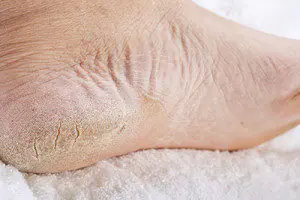
One of the most common causes of dry skin on the ankles is a fungus. Its development is provoked by excessive sweating, small wounds, and neglect of hygiene standards. In this case, the fungal pathogen penetrates the deep layers of the epidermis and infects the cells.
Signs of foot fungus:
- redness;
- change in integrity (skin surface bursts and cracks);
- peeling and drying;
- itching;
- rashes.
Where can you get infected with fungus:
- Bath or sauna.
- Swimming pool, public shower.
- When using someone else's shoes.
- When wearing someone else's underwear.
Ways to treat foot fungus:
- Use of local antifungal agents (Clotrimazole, Candide, Miconazole).
- If the skin cracks during treatment, dry skin should be cleaned off as much as possible.
- Use deodorants to avoid excessive sweating of the feet. Humidity encourages fungal growth.
Treatment of fungus requires an integrated approach and patience. You will have to use these methods for at least 3 weeks.
Metabolic disease
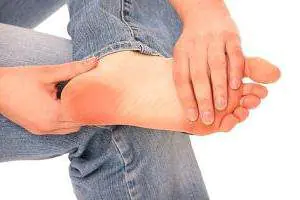
Sometimes the skin on the ankles cracks due to metabolic disorders. The main cause of the pathology is a violation of carbohydrate and protein metabolism.
To confirm this diagnosis, it is necessary to carry out a differential diagnosis with fungal infection and an allergic reaction.
The most dangerous metabolic disorder is type 1 or type 2 diabetes. It provokes a change in the exchange of nutrients between the cell and the intercellular space. Nerve endings do not perform their function, as a result the skin cannot adequately respond to changes in body temperature and environmental humidity.
This leads to excessive dryness of the epidermis. In the future, it cannot create the necessary protection from the harmful properties of the environment, which aggravates the problem.
The skin begins to itch terribly, peel and crack.
In a huge number of cases, diabetes is not diagnosed or detected untimely. Therefore, if you notice changes in the structure of the skin anywhere in the body, you need to donate blood for the presence of glucose on an empty stomach and do a glucose tolerance test.
Disorders of protein metabolism most often lead to the accumulation of oxidation products in the body. They cause damage to the cell wall, making it fragile and brittle. In addition, protein deficiency in the body slows down the construction of new cells, this affects the functioning of all body systems, and therefore well-being, productivity, and appearance.
Allergic reactions
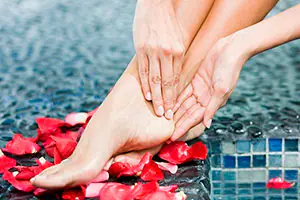
Allergic reactions can be triggered by many factors:
- synthetic underwear;
- washing powder or fabric softener;
- material of shoes or fasteners;
- eating foods that cause allergies (citrus fruits, spices, etc.).
Symptoms of allergic drying of the skin on the ankle bones:
- irritation and peeling after contact of the irritant with the bare surface of the body;
- itching;
- small rashes;
- edema and swelling;
- pain or discomfort.
Treatment of allergic skin reactions:
- local antihistamines (Allergodil, Avamis, etc.);
- traditional medicine methods;
- limiting contact with the allergen;
- taking antihistamines orally (Diazolin, Suprastin, etc.).
Peeling skin during pregnancy
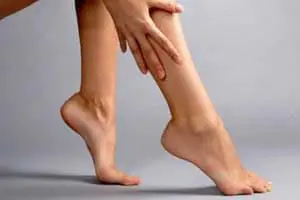
If the skin on the ankles peels during pregnancy, this is the first sign of vitamin deficiency in a woman’s body.
As you know, a child takes everything necessary for its development from the mother’s body. These are calcium, protein, polyunsaturated fatty acids and similar microelements and substances.
First of all, when there is a lack of vitamins and other necessary complexes in the body, women’s hair begins to dry out and nails become brittle.
At this time, the consistency of the skin of the lower and upper extremities may also change. The skin on the ankles and arms begins to dry, peel and itch.
To correct the situation, it is necessary to urgently use replacement therapy, otherwise teeth may deteriorate, vision may be impaired, and even diseases of the nervous system may develop.
Causes of dry skin on the ankle bone during pregnancy:
- Deficiency of vitamins A, E, D.
- Lack of protein in the diet.
- Excess simple carbohydrates.
- Exacerbation of diseases of the gastrointestinal tract.
- Contamination of the body with oxidation products.
- Consuming a large amount of fiber, which can remove all the toxins that poison the body.
- Taking a double dose of vitamin C and E as antioxidants.
- B vitamins to improve the functioning of nerve cells.
- Long-term use of prenatal vitamins before, during and after pregnancy.
- Use of local moisturizing preparations based on animal or vegetable fat. Olive oil is best.
- Timely cleansing of the skin from dead cells using a scrub.
Neurology as a cause of dry skin on ankles
Sometimes, due to leg injuries, the integrity of the nerve fibers is disrupted, which leads to changes in the trophism of all soft tissues of the limb.
The disease begins with dry skin and can result in drying out of the limb.
To avoid such complications, after a leg injury, you need to follow all the doctor’s recommendations during rehabilitation and take prescribed medications to restore damaged tissues (glycosaminoglycans, chondroprotectors, B vitamins).
Foot massage has a good therapeutic effect; it increases blood circulation and improves trophism of all ankle cells.
Traditional methods for treating dry skin on ankles
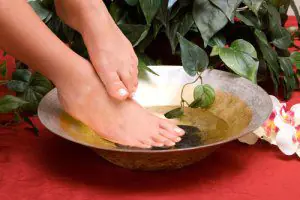
Traditional medicine has a beneficial effect on the condition of the skin, increases its elasticity, softens and promotes healing. However, traditional recipes should be used only after consultation with a doctor. For neurological diseases, diabetes and other systemic disorders, such therapy will not help; the root cause must be treated.
For rashes and skin inflammation, you can take warm baths with decoctions of sage, chamomile or oak herbs.
For excessive dryness, vegetable oils have a good effect. Corn, olive or flax oil is best.
Important! You should not apply vegetable oils to superficial damage and deep wounds, this can only aggravate the condition of an allergic reaction.
So, the causes of dry skin on the feet are often complex. To eliminate them, it is first necessary to exclude systemic diseases (diabetes mellitus, thyroid pathology) and only then apply local treatment.
No cream helps. I tried everything: baby cream, olive oil, even Rescue Balm! The result is zero. In fact, I've had this thing for a long time. It looks like this: in the ankle area there is a FLAT LINE, underneath there is normal soft skin and on top about five centimeters the skin is red, dry and flaky!! Feels like sandpaper. It's like a shoe print! I wear wool tights and jeans all winter. What is this *** and can it be removed at all? In the summer it more or less goes away, but the line is still visible.. Please advise how to deal with this. Who had the same problem? Thank you in advance
Woman.ru experts
Find out the opinion of an expert on your topic
Aleynikova Natalya ValerievnaPsychologist. Specialist from the site b17.ru
Zubkova Anna AndreevnaPsychologist, Gestalt therapist. Specialist from the site b17.ru
Khairullina Rosa RinatovnaPsychologist. Specialist from the site b17.ru
Korotina Svetlana YurievnaPsychotherapist. Specialist from the site b17.ru
Ekaterina Alekseevna VasyukhinaPsychologist, Crisis counseling. Specialist from the site b17.ru
Vera Vladimirovna ZolotykhPsychologist. Specialist from the site b17.ru
Elena BasanovaPsychologist, Family psychologist Skype. Specialist from the site b17.ru
Boyko Inessa BorisovnaPsychologist, Online consultant. Specialist from the site b17.ru
Nevzorova Sofya IgorevnaPsychologist. Specialist from the site b17.ru
Prokopenko Elena AlexandrovnaPsychologist. Specialist from the site b17.ru
Is there any way to go to a dermatologist?!
Maybe some kind of dermatitis...or maybe just irritation.
A month ago, the skin on my ankles turned red, peeled and became crusty in some places, my legs just above the knee were completely covered with microcracks, a dry crust appeared on my body in places, but I was on a strict diet, limiting myself in many ways, and taking vitamins. Yesterday I was at the dermatologist, there was a huge line and everyone was diagnosed with “allergy to cold”. He prescribed me Filtrum, Locobase Ripea cream and antihistamine tablets, and advised me not to use a washcloth so as not to irritate the skin even more. By the way, the usual cream even stung my skin.
author, it looks like you are allergic to the cold.
You know, I observed the same thing in myself over the course of 3 winters. It went away on its own in the spring and only appeared again in the winter. And there was also just a mark (as you describe) as if from boots. But these winters I actually wore short ankle boots - in winter I mostly wear trousers and jeans, so I specifically bought “short” shoes.
BUT last year I decided to change my shoes and bought myself high winter boots - regular ones that can be worn with a skirt and at the same time not too bulky so that they don’t get in the way under my pants. And lo and behold! This is the second winter I have not had this problem with my ankles. There is no peeling or redness. Apparently there was such a reaction on the skin due to the cold.
Author, think, maybe you should change your winter shoe model?
switch from boots to boots. All will pass.
it really comes from the boots. They seem comfortable, but they still rub.
Related topics
firstly, this is a lack of vitamins) and secondly, try applying cheap velor cream!! my skin peeling goes away in 2 days. always helps me out)
author, it looks like you are allergic to the cold.
You know, I observed the same thing in myself over the course of 3 winters. It went away on its own in the spring and only appeared again in the winter. And there was also just a mark (as you describe) as if from boots. But these winters I actually wore short ankle boots - in winter I mostly wear trousers and jeans, so I specifically bought “short” shoes.
BUT last year I decided to change my shoes and bought myself high winter boots - regular ones that can be worn with a skirt and at the same time not too bulky so that they don’t get in the way under my pants. And lo and behold! This is the second winter I have not had this problem with my ankles. There is no peeling or redness. Apparently there was such a reaction on the skin due to the cold.
Author, think, maybe you should change your winter shoe model?
Looks like neurodermatitis. If there is itching and peeling, it’s definitely neurodermatitis.
You need to go to the doctor, and not ask on the forum. Check your hormones, blood, and vegetative-vascular system. It doesn’t look like an allergy, it doesn’t look like vitamin deficiency, and a circulatory disorder doesn’t look like it either. It is either nervous or cutaneous. Replace wool tights with thick synthetic ones, although this is unlikely to help. More like dermatitis. In any case, see an endocrinologist and dermatologist.
allergy to cold. I have the same thing(. I found a solution - in the morning and evening, Garenye milk with almond oil (it really suited me). A slight redness remains, but there is no dryness or flaking. Otherwise, my legs were literally burning(. And wait for warming - this will not happen in the summer .
My sister has similar symptoms, the doctor diagnosed neurodermatitis. At this stage, outside of exacerbation, the non-hormonal drug Berestin helps very well
yes, very similar to neurodermatitis. Be sure to exclude woolen items. Contact of such skin with woolen items only aggravates the situation. I placed pieces of cotton fabric between the tights (or socks) and the skin.
donate blood (as you have already written above), you will find out. what should be excluded from the diet.
I won’t recommend medications, this is very individual, but I will gladly recommend a non-hormonal remedy for dryness and itching, because it helps me very well. This is Cetaphil lotion, especially for atopics. You can buy it at the office. website, it lasts a long time if the lesion is not large.
A month ago, the skin on my ankles turned red, peeled and became crusty in some places, my legs just above the knee were completely covered with microcracks, a dry crust appeared on my body in places, but I was on a strict diet, limiting myself in many ways, and taking vitamins. Yesterday I was at the dermatologist, there was a huge line and everyone was diagnosed with “allergy to cold”. He prescribed me Filtrum, Locobase Ripea cream and antihistamine tablets, and advised me not to use a washcloth so as not to irritate the skin even more. By the way, the usual cream even stung my skin.
Ksenia, despite the fact that several years have already passed since your question, I would like to know what diagnosis you were given and what medications you were treated with. My mother has the same problem, first a reddish stripe appeared around the ankle on one leg, and after a few months and on the other, she contacted a dermatologist who prescribed her medications for neurodermatitis and allergies, but so far there has been no positive result. Thanks in advance.
Looks like neurodermatitis. If there is itching and peeling, it’s definitely neurodermatitis. You need to go to the doctor, and not ask on the forum. Check your hormones, blood, and vegetative-vascular system. It doesn’t look like an allergy, it doesn’t look like vitamin deficiency, and a circulatory disorder doesn’t look like it either. It is either nervous or cutaneous. Replace wool tights with thick synthetic ones, although this is unlikely to help. More like dermatitis. In any case, see an endocrinologist and dermatologist.
There is redness on the ankle, the skin is dry, peeling, sometimes an ulcer appears, purulent and does not heal for a long time, I treat it with salt, what should I do?
It’s the same for me. I went to the KVD. They said it was just changed skin, like on the heels. It's like physiology. They prescribed Belosalik ointment (400 rubles). Apply twice a day. It makes the rough skin soft, but the red spot remains. This is the only thing that helped more or less.
Vistim always helps me a lot with dryness. I usually smear it on my hands, but I think it will work on my ankles too.
I once watched a program, they said that such skin in the ankle area is formed due to varicose veins, by the way, I have the same thing on one leg, and I definitely have varicose veins. I also use baby cream
Good afternoon I had the same problem, the skin on the ankle of my left leg was peeling, it was especially active in the summer, it didn’t peel in winter, but it was different in color (red) and in texture - rough. No matter what I applied, nothing helped. Then our family moved from the apartment to our own house with a plot of land, in the spring I discovered the grass CElandine on the plot and began to smear my problem with the juice of a freshly picked leaf. Since the juice stains the area in contact with the skin, I covered this area with a band-aid! This continued throughout the summer, almost until the first frost. The skin on my ankle no longer peels. Good luck!
Complaint
Moderator, please note that the text contains:
The complaint has been sent to the moderator
The page will close automatically
in 5 seconds
Forum: beauty
New for today
Popular today
The user of the Woman.ru website understands and accepts that he is fully responsible for all materials partially or fully published by him using the Woman.ru service.
The user of the Woman.ru website guarantees that the placement of materials submitted by him does not violate the rights of third parties (including, but not limited to copyrights), and does not damage their honor and dignity.
The user of the Woman.ru site, by sending materials, is thereby interested in their publication on the site and expresses his consent to their further use by the editors of the Woman.ru site.
Use and reprinting of printed materials from the woman.ru website is possible only with an active link to the resource.
The use of photographic materials is permitted only with the written consent of the site administration.
Placement of intellectual property objects (photos, videos, literary works, trademarks, etc.)
on the woman.ru website is permitted only to persons who have all the necessary rights for such placement.
Copyright (c) 2016-2019 Hirst Shkulev Publishing LLC
Online publication “WOMAN.RU” (Zhenshchina.RU)
Certificate of registration of mass media EL No. FS77-65950, issued by the Federal Service for Supervision of Communications,
information technologies and mass communications (Roskomnadzor) June 10, 2016. 16+
Founder: Limited Liability Company "Hurst Shkulev Publishing"



